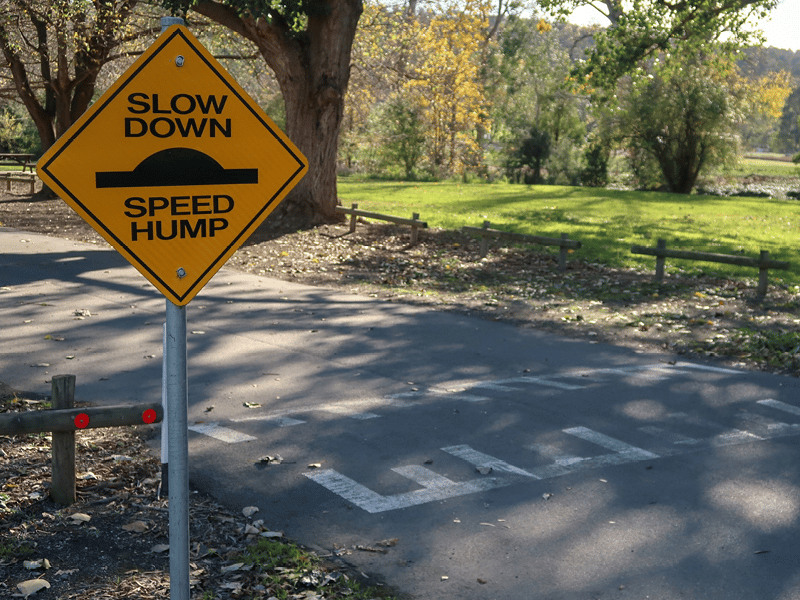

Although speed humps are deployed in a wide range of settings, did you know that it’s well within your power to request them for your neighbourhood streets?
All over Australia, there are pockets of tight knit communities that populate the suburbs. In fact, many would argue that this is the primary appeal of living in these types of areas, especially one where kids can play on the street together with less hazards than what one would normally face in inner city environments.
However, that’s not to say that suburban streets are guaranteed to be safer, and sometimes they need a little bit of outside help to make them so. As speed is the primary factor in most vehicle accidents, many residential streets have traffic calming measures in place to reduce the likelihood of speeding vehicles near their homes.
If you have concerns about road safety in your neighbourhood and are wondering whether you can take the bull by the horns and install speed humps yourself, unfortunately the answer is usually no. Instead, we’ll show you how to request traffic calming devices for your suburb the right way, and how to improve your odds at getting a positive outcome.
When done well, traffic calming is a strategy that controls the traffic volume and vehicle speed, reduces accident rates, minimises noise levels, combats air pollution and even aids fuel consumption. The concept is widely embraced as a form of local area traffic management, particularly as a means to boost safety in residential neighbourhoods.
To purposefully slow the flow of traffic and reduce speeds down to around 10 to 40 kilometres per hour, a range of third party devices can be installed for road safety. Although there are many private enterprises that stock, manufacture and sell traffic calming devices, the law says that civilians are not permitted to take it upon themselves and install them without the approval of your local council.
In fact, many local councils have their own traffic management plans already in place. While the goal is often to lower traffic speeds, reduce accidents and reduce the volume of traffic flowing through residential streets, approaching this usually involves traffic data collection, wider community consultation, and the selection of the right types of traffic calming structures, with one of the most common being speed humps.
Councils will often install devices such as speed platforms, roundabouts, traffic islands and kerb build-outs to provide a safe environment for pedestrians and cyclists, discourage non-local traffic in neighbourhood streets, and moderate vehicle speeds.
Given the scale of such a task, this process is often ongoing and ever changing as the needs of the community evolve over time. In turn, asking for speed humps in your street is often as simple as making a submission directly to your local council and hoping they prioritise your request.
To improve your chances, consider starting a petition or gather as many of your neighbours as you can to co-sign a letter. If your street or area has previously been the target of hooning or any other antisocial behaviour on the road, be sure to include any evidence such as newspaper reports or social media posts to add to your submission.
From there, traffic engineering officers will often then undertake an assessment, taking into consideration the following before making any recommendations or proceeding to install any new devices.
In Australia, road safety is an extremely serious business – and it should be. Although getting behind the wheel of a car is something that many of us do multiple times per day, the likelihood of an accident is sadly on the rise. By encouraging your local council to do something about road safety in your street, you can rest easy knowing that you’ve done your part.
At Speed Humps Australia, we’ve spent twenty years focusing on one thing: to provide one style of product, and to do it exceptionally well. We have worked tirelessly to develop specifications that do not fade or deteriorate, are easy to install, and are made from high-quality, recycled rubber for minimal environmental impact.
With just a handful of our clients around the nation including KFC, Taco Bell, McDonalds and numerous local governments and mining operations, our rumble bars, speed humps and wheel stops have been purposefully designed to truly go the distance.
As our design and production is all handled in house and supplied Australia wide, get in touch with us today to request a quote or discuss how we can help with providing a tailored solution to your unique project requirements.



For 10 years, our focus has been on one thing: to provide one style of product and to do it well.
Our wheel stops, speed humps and rumble bars meet Australian Standards, don’t fade, and we’ve never needed to replace one.

For 10 years, our focus has been on one thing: to provide one style of product and to do it well.
Our wheel stops, speed humps and rumble bars meet Australian Standards, don’t fade, and we’ve never needed to replace one.